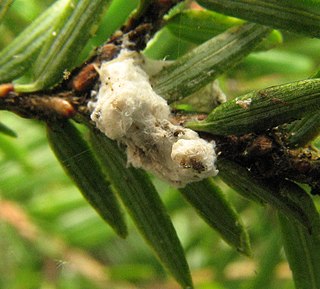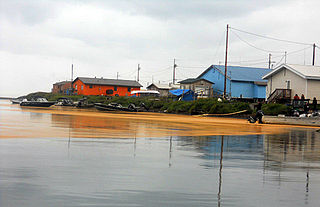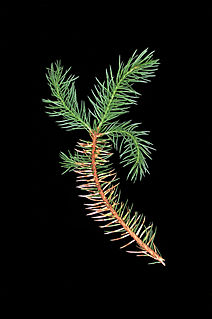
Taiga, generally referred to in North America as boreal forest or snow forest, is a biome characterized by coniferous forests consisting mostly of pines, spruces, and larches.

A spruce is a tree of the genus Picea, a genus of about 35 species of coniferous evergreen trees in the family Pinaceae, found in the northern temperate and boreal (taiga) regions of the Earth. Picea is the sole genus in the subfamily Piceoideae. Spruces are large trees, from about 20–60 m tall when mature, and have whorled branches and conical form. They can be distinguished from other members of the pine family by their needles (leaves), which are four-sided and attached singly to small persistent peg-like structures on the branches, and by their cones, which hang downwards after they are pollinated. The needles are shed when 4–10 years old, leaving the branches rough with the retained pegs. In other similar genera, the branches are fairly smooth.
Spruce Meadows, is a multi-purpose sports facility near Calgary, Alberta built by the Southern family which opened in 1975.

Choristoneura fumiferana, the eastern spruce budworm, is a species of moth of the family Tortricidae native to the eastern United States and Canada. The caterpillars feed on the needles of spruce and fir trees. Eastern spruce budworm populations can experience significant oscillations, with large outbreaks sometimes resulting in wide scale tree mortality. The first recorded outbreaks of the spruce budworm in the United States occurred in about 1807, and since 1909 there have been waves of budworm outbreaks throughout the eastern United States and Canada. In Canada, the major outbreaks occurred in periods circa 1910–20, c. 1940–50, and c. 1970–80, each of which impacted millions of hectares of forest. Longer-term tree-ring studies suggest that spruce budworm outbreaks have been recurring approximately every three decades since the 16th century, and paleoecological studies suggest the spruce budworm has been breaking out in eastern North America for thousands of years.

Chrysomyxa ledi var. rhododendri is a plant pathogen responsible for the disease spruce needle rust.

Choate Island, also known as Hog Island, is an island located in the Essex River Estuary in Essex, Massachusetts. It is part of the Crane Wildlife Refuge, which is owned and managed by The Trustees of Reservations. The 135-acre (0.55 km2) island is a refuge for a variety of birds and animals. It is surrounded by a salt marsh and has a spruce forest which was planted in the 1930s and makes the island easily visible from much of the surrounding area. The island has been inhabited by the Native Americans of the area, and was visited by early Europeans, who established farming on the island. The Choate House, built around 1730, remains relatively unchanged.

The interior Alaska–Yukon lowland taiga ecoregion, in the taiga and boreal forests biome, of far northern North America.

Operation Migration was a nonprofit, charitable organization, which developed a method using ultralight aircraft to teach migration to captive-raised, precocial bird species such as Canada geese, trumpeter swans, sandhill cranes, and endangered whooping cranes.

Adelges is a genus of insects which feed on conifers. Excepting galls formed by the spruce gall midge, galls are caused by aphid-like insects of the superfamily Phylloxeroidea commonly known as the spruce gall adelgids. They have complex life cycles, some species feeding exclusively on spruce, others feeding on spruce and an alternate conifer. However, galls characteristic of each species are formed only on spruce. Six generations are usually needed to complete the 2-year cycle, and in the case of species having an alternate host, winged adults about 2 mm long are formed only in the generations that move from one host to the other.

Chrysomyxa is a genus of rust fungi in the family Coleosporiaceae. The genus, widespread in the Northern Hemisphere, contains about 23 species. Rust fungi in the genus Chrysomyxa occur in boreal forests of the northern hemisphere on Pinaceae,, and most species alternate to angiosperm hosts in the Ericaceae.

Chrysomyxa ledicola is a plant pathogen responsible for the disease large-spored spruce-Labrador tea rust. It affects white spruce, black spruce, Sitka spruce, Englemann spruce, and Labrador-tea. It is also the cause of the orange goo that covered the Iñupiat village of Kivalina, Alaska in the summer of 2011.
Chrysomyxa abietis, or spruce needle rust, is a species of rust fungi in the Coleosporiaceae family that is native to eastern Europe and northern Asia. It was introduced to Australia, New Zealand and the United States.
Chrysomyxa himalensis, is a species of rust fungi in the Coleosporiaceae family that can be found on Rhododendron and Picea species in the Himalayan region of southern Asia and was introduced in the United States.
Spruce broom rust or yellow witches' broom rust is a fungal plant disease caused by the basidiomycete fungus known as Chrysomyxa arctostaphyli. It occurs exclusively in North America, with the most concentrated outbreaks occurring in northern Arizona and southern Colorado on blue and Engelmann spruce, as well as in Alaska on black and white spruce. This disease alternates its life cycle between two hosts, with the spruce serving as the primary host and bearberry serving as the secondary or alternate host. The name for the disease comes from the distinctive “witches broom”, commonly yellow in color, which forms on the spruce after young needles have been infected. Management must be carried out through physical or mechanical methods, such as the pruning of brooms or the removal of the secondary host from the area, because no chemical control measures have yet been determined to be economically effective. Generally, spruce broom rust is seen as a mostly cosmetic issue, and it is very rarely the direct cause of tree death; however, research has shown a reduction in overall productivity and health of infected trees, making it an important issue for logging and timber companies.

Chrysomyxa weirii, is a fungus that causes a disease, commonly known as Weir's cushion rust, of spruce trees. It is mostly a cosmetic problem, causing yellowish spotting and banding on spruce needles, but in some cases can cause severe premature defoliation. Weir’s cushion rust can also disfigure and reduce growth of spruce trees by targeting the tender needles of newly emerging shoots. This pathogen's spores are spread by wind and water splash and germinate to infect newly developing needles on the same spruce, or neighboring spruce trees. Unlike many other rust disease pathogens, C. weirii is autoecious, only infecting spruce trees. C. weirii is also microcyclic, producing only two of the five possible spore stages common in rust fungi. Trees affected by Weir's cushion rust usually have obvious symptoms, but if treated correctly, the disease can be managed.
Chrysomyxa cassandrae is a fungus that occurs throughout the North Temperate Zone wherever Chamaedaphne calyculata occurs, independent of host alternation. Aecial hosts include white spruce.

Chrysomyxa ledi is a fungus. It occurs in Eurasia throughout the range of its broad-leaved hosts. The aecial stage is found on native and exotic spruces in Europe, including white and Engelmann spruces.
Chrysomyxa nagodhii is a species of rust fungus in the family Coleosporiaceae. It was described as new to science by Canadian mycologist Patricia E. Crane in 2001. It probably occurs throughout the range of Ledum decumbens and Rhododendron groenlandicum. On Picea, spermogonia and aecia occur on distinct rusty yellow bands on current-year needles.
Chrysomyxa reticulata has been found on Ledum decumbens and Ledum groenlandicum in both eastern and western Canada, as well as Wisconsin, Washington, and California, in the United States, but the aecia are so far known only from artificial inoculation of white spruce.
The spruce cone rust, caused by the rust fungus Chrysomyxa pirolata Wint., affects spruces in 3 continents, including white spruce in Canada. Alternate hosts of the fungus are several species among 3 genera of wintergreen: Pyrola spp., Orthilia spp., and Moneses spp.. Diseased cones open prematurely and orange-yellow aeciospores are sometimes produced in such quantity as to color the forest floor and lake surfaces. Up to half of a cone crop can be affected, and most of the affected cones do not produce viable seed. Some localities commonly experience damage to 20% to 30% of cone crops, a factor to be considered in the siting of seed orchards.










